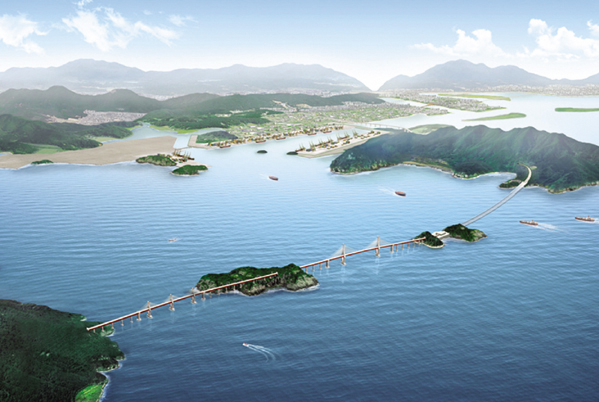Busan-Geoje Project to Set Milestone
in Korean History of Civil Engineering
Daewoo E&C heads a consortium of a BTO project involving Korea's first immersed tunnel
 The mammoth Busan-Geoje Fixed Link project is set to represent a milestone in Korean history of civil engineering as it will adopt such advanced engineering technologies as the introduction of an immersed tunnel for the first time in Korea.
The mammoth Busan-Geoje Fixed Link project is set to represent a milestone in Korean history of civil engineering as it will adopt such advanced engineering technologies as the introduction of an immersed tunnel for the first time in Korea.
The latest technologies the project will employ also include Korea's first durable structure designed on the basis of performance: DuraCrete, Korea's first Mass Concrete Box Structure and the first application of a weather forecasting system in a domestic project, Koo Im-sig, managing director of Daewoo E&C and concurrently chief of construction at GK Fixed Link Corp., said.
The projected bridge with an immersed tunnel, the world's largest one and Korea's first, has begun to take shape in waters off the South East Coast as contractors are working on its foundations. The bridge, tentatively named as "Geoga Bridge,"will connect Cheonseong-dong, Gangseo-gu, Busan Metropolitan City and Yuho-ri, Jangmok-myeon, Geojae City, South Gyeongsang Province.
 If completed by 2010, the bridge with an immersed tunnel will serve as a fantastic tourism and transportation center off the South East Coast. The immersed tunnel is a method in which pre-cast tunnel elements are placed undersea into a dredged trench, then joined and covered.
If completed by 2010, the bridge with an immersed tunnel will serve as a fantastic tourism and transportation center off the South East Coast. The immersed tunnel is a method in which pre-cast tunnel elements are placed undersea into a dredged trench, then joined and covered.
The tunnel, 3.7 km in total length, will be built by immersing 18 elements, each weighing 45,000 to 50,000 tons into the maximum depth of 38 meters, the deepest one in the world before backfilling them.
The project is an environment-friendly as most concrete structures will be pre-cast onshore - at the manufacturing yard in the nearby Tongyeong industrial complex -, then assembled and completed at site after transportation to enhance quality and minimize possible environmental issues. The caisson foundation for the bridges are pre-cast at the on-shore yard, transported to the construction job site and installed to improve quality and ensure environment-friendly construction.
The state-of-the-art bridge, 8,204 meters in total length,
 will have a 21.6 meter-wide two-lane road in each direction. Also the highlight of the bridge will be a 1.87 km-long, two-pylon cable-stayed bridge with a 470 meter-long main span and156 meters in height and a 1.65 km-long, three-pylon cable-stayed bridge with a 230 meter-long main span. The bridge deck is fixed to the pylon by inclined cables so that cables are installed symmetrically from both sides of the pylon.
will have a 21.6 meter-wide two-lane road in each direction. Also the highlight of the bridge will be a 1.87 km-long, two-pylon cable-stayed bridge with a 470 meter-long main span and156 meters in height and a 1.65 km-long, three-pylon cable-stayed bridge with a 230 meter-long main span. The bridge deck is fixed to the pylon by inclined cables so that cables are installed symmetrically from both sides of the pylon.
The three-pylon is considered to have a lower structural efficiency due to its complexity and asymmetry, yet have more economic benefits, compared to the two-pylon one, as are seen with the likes of Millau Viaduct of France.
The Busan-Geoje Fixed Link project is a private investment BTO (Build-Transfer-Operate) project. BTO means that the concessionaire, GK Fixed Link Corp. invests the capital to complete the project, then the ownership over the project facilitates is transferred to the government simultaneously upon completion of the construction of the project facilities,
 while the concessionaire recovers the invested capital and makes profits by the assigned operation right for 40 years as agreed with the authorities.
while the concessionaire recovers the invested capital and makes profits by the assigned operation right for 40 years as agreed with the authorities.
GK Fixed Link Corp comprises of a consortium of eight Korean top-ranking contractors, including Daewoo E&C.
Daewoo E&C shoulders a 43.45 percent share of the project budget, followed by Daelim Industrial (21.3 percent) and Doosan Industrial Development (13.6 percent).
The total value of the project is worth 2.3 trillion won. Construction costs accounts for 87.65 percent of the total project value.
Design and construction proceed in parallel for the efficient project management and consequently reducing construction time and saving costs.
What is the foremost one of the project's economic benefits is to cut the distance between Busan and Geoje from 140 km to 60 km, thus reducing travel time from 130 minutes to 50 minutes. It will also bring financial benefits, estimated at more than 400 billion won
The bridge will relieves traffic jam on the South Coast Expressway,
 forming a U-shape aea, while connecting with the Daejeon-Tongyeong Expressway, the Gyeongbu Expressway and the Daegu-Tongyeong Expressway. It is expected to contributes to the development of the local economy - developing a huge local market, bringing more than 1.2 trillion won of consumption and employment. nw
forming a U-shape aea, while connecting with the Daejeon-Tongyeong Expressway, the Gyeongbu Expressway and the Daegu-Tongyeong Expressway. It is expected to contributes to the development of the local economy - developing a huge local market, bringing more than 1.2 trillion won of consumption and employment. nw
An artist conception shows the grandiose Busan-Geoje Project, which includes a three-pylon cable-stayed bridge and an immersed tunnel, Korea's firsts in history of civil engineering.
Koo Im-sig, managing director of Daewoo E&C and concurrently chief of construction at GK Fixed Link Corp.
Daewoo E&C officials discuss the construction of the Busan-Geoje project, being undertaken by a BTL consortium headed by Daewoo E&C.
3Fl, 292-47, Shindang 6-dong, Chung-gu, Seoul, Korea 100-456
Tel : 82-2-2235-6114 / Fax : 82-2-2235-0799